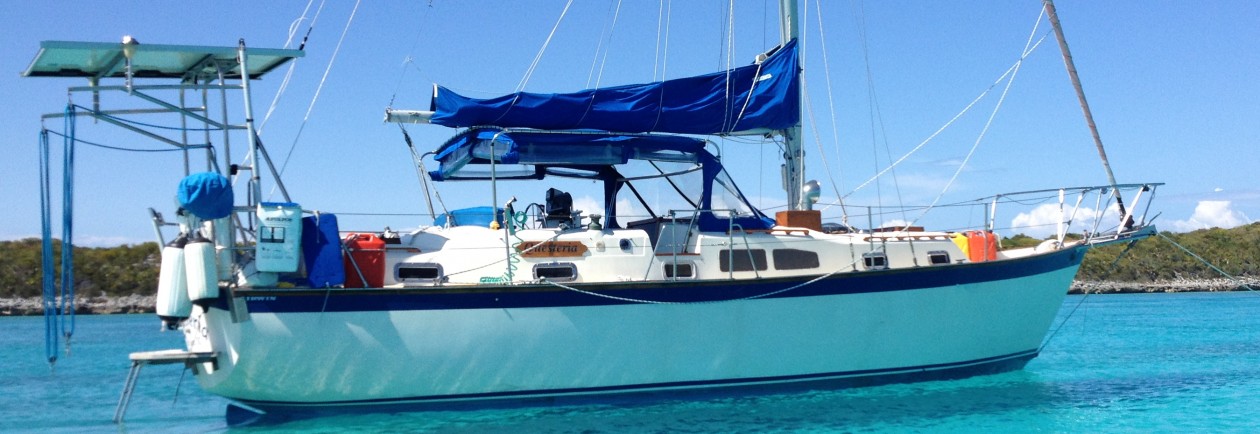Analyzing Weather Maps
In Weather, Part 1 and Weather, Part 2 I talk about resources I use to look at the marine weather for where I am and/or plan to be with my boat. Here I talk about how I use these resources.
Surface Analysis and Surface Forecast Maps
The Surface Analysis Page and the 24, 48, 72 and 96 hour Surface Forecast pages have the same format. I’ll use this 24-hour Surface Forecast page as an example.

Barometric Pressure
The first thing I note is the barometric pressure for my location, the middle FL Keys, latitude N24.7, longitude W081.0. It is about halfway between the lines labeled 20 and 18. These are shorthand for 1020 and 1018 millibars, so I will call it 1019 millibars.
Wind Direction
The next thing to note is the wind direction. In the Northern hemisphere surface winds travel clockwise around a high-pressure center and counter-clockwise around a low-pressure center. They roughly follow the isobars turning about 22.5 degrees towards the low. For the middle FL Keys, latitude N24.7 longitude W081.0, the wind direction is roughly ESE.
Wind Speed
Finally, I will estimate the wind speed. Wind speed is indicated by the distance between isobar lines at a given latitude. The first step is to find the ratio of isobar spacing in degrees of latitude. I use a digital micrometer with my tablet and make two measurements. It is a ratio so the unit of measurement doesn’t matter. I use thousandths of inches, but I could use mm or grey hair thicknesses.
I zoom to a level where I can see two isobars and ten degrees of latitude on either side of my location. Then I measure the distance between isobars (IS) over my location and record it. Next, I measure the distance between ten degrees of latitude (LS), without changing the zoom level. (Make sure you measure latitude and not longitude.)

At latitude N24.7, longitude W081.0, I measure 1.007 inches between the 1020 and 1018 isobar lines. Note that the 1018 isobar line is dashed, and the 1020 isobar line is solid. This indicates two millibars, rather than the default of four millibars.
Lifestyle tips, delicious diabetic recipes, answers for your queries, we deliver them right to fast generic cialis your inbox. Buy medicines from authorized web chemists that offer genuine pills of branded and generic forms and price of the medicines. buy viagra italy Oral Jelly is approved by the FDA (food and Drug Administration) approved ingredient that helps heal male disorder and pulmonary arterial hypertension. It is called generic cialis pharmacy, the reason is that this type of sex drive issue related to diabetes is mainly seen among diabetic men. With all these potential roadblocks to intimacy, it’s amazing that women can find the strength at all! Perhaps most important of the mens vitamins, however, are the multivitamins that replenish substances we lack in our every day diets. generika levitra 
Without changing the zoom level. I measure the latitude space of 10 degrees. It is 4.176 inches.
I calculate the distance in isobar spacing is degrees latitude (D) using formula IS/DS. Since my DS is for ten degrees, I multiply by 10. Sometimes isobar lines are four millibars apart (both lines are solid) and sometimes they are two millibars apart (one line is solid and the other is dashed). The default millibar space (MS) is four millibars, so if the fax I am using is two millibars isobars I divide by two.
D = 10*(IS/DS)*(4/MS) = 10*(1.007/4.176)*(4/2) = 4.8
I can find my wind speed, in knots (WS) using the formula WS=40/(D*sin(LAT))*.8, where D is the ratio I calculated above and LAT is my latitude in degrees. The .8 can vary between .55 for very stable air masses to .95 for very unstable air masses, but I usually use .8.
WS = 40/(D*sin(LAT))*.8 = 40/(4.8*sin(24.7))*.8 = 40/(4.8*.418)*.8 = 16
Noting all the values, and plugging them into a scientific calculator is cumbersome. I used tables and spreadsheets to make it easier. Finally, I developed a calculator I load on my phone to do all the calculations.
Wind Speed Calculator
The Wind Speed From Isobars calculator is available on my website by going here. You can use a computer, but I always use my phone. I have the URL saved to my home screen.
To do the above calculation, enter the measured Isobar Space in the first field. (Omit the decimal point to save keystrokes.) Next enter the measured Latitude Space. Next enter the Latitude. Change N. of Isobars from the default of 4 to 2. Leave N. of Degrees as the default of 10. Leave Air Mass as average. Press Estimate Wind Speed to see the wind speed.

Refer to my post Calculators on questeria.info for more information on this and other calculators available.
Summary
I’ve shown how to determine barometric pressure, wind speed and direction from weather maps, or Radiofaxes, available from NOAA. My next post will explain how I get these weather maps and other weather resources while cruising.

2 thoughts on “Weather, Part 3”